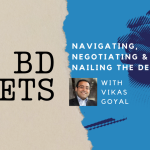Building Momentum and Leverage: How Pandion Ended Up Acquired by Merck

Vikas Goyal, SVP, business development, Pandion Therapeutics (now part of Merck)
The news release crossed the wires 6:45 am Feb. 25. Within minutes, my inbox started filling with some awesome congratulatory notes. In a few of those notes, there were also some questions about how fast it all happened.
Pandion Therapeutics, the Watertown, Mass.-based company where I worked as chief business officer for 18 months, had just been acquired by Merck for $1.85 billion, or $60 a share in cash.
We were a startup, developing treatments for autoimmune disease, and barely four years old. We had only spent about $85 million to date. The concept was outlined in this January 2018 story in TR about our Series A financing.
Three years later, by anyone’s estimation, this was the stuff of biotech startup dreams.
How did it happen? What did we do? Why were we so fortunate?
From my perspective, the story starts where all biotech stories do – with the science.
Science Comes First
T cell maturation is a chaotic and iterative process. V(D)J recombination creates an almost infinite range of immature immune cells. Clonal selection then curates these cells down to a subpopulation that are able to recognize pathogens (positive selection) but do not react to self (negative selection). For T cells, this elegant natural selection happens in the thymus.
Of course, in reality, biology is stochastic. A percentage of self-reactive immune cells will escape clonal selection and can, unfortunately, go on to attack normally healthy cells, resulting in autoimmune disease.
To counterbalance those fugitives, a very special and idiosyncratic subpopulation of a subpopulation of immune cells is also created in the thymus: the self-reactive FOXP3+ regulatory T cell (Treg).
Perhaps uniquely among immune cell populations, some of our self-reactive T cells are allowed to mature because they present a magical set of properties. Instead of attacking our body, these Treg cells protect our body from their more hostile effector T cell and other immune cell cousins.
Pandion’s lead program, PT101, was designed to activate and expand these Treg cells in people, with the therapeutic goal of helping these special cells do their job more effectively in patients living with autoimmune disease.

Jo Viney, CSO, Pandion Therapeutics
Since the company’s founding by Jo Viney and Alan Crane, our mission has consistently been to build a platform and pipeline of drugs that activate the regulatory immune system. Our human proof-of-mechanism data for PT101 and our broader autoimmune pipeline were catalyzing factors in our acquisition by Merck.
Getting to that deal was also an iterative process with a fair amount of chaos and selection along the way. Looking backwards, the success of our business development approach at Pandion centered on (1) creating momentum; (2) setting hard goals that would be unambiguously expressed in term sheets; and (3) having some leverage.
Momentum
Chaos, oddly enough, can help build momentum.
We approached a broad set of potential partners. We sought out trusted introductions to partners, and created introductions where we needed. Whenever we caught a whiff of interest, my job was to lean in and create sustained momentum that might lead somewhere productive. Often, it was a matter of listening carefully for subtle clues, and letting strategic interest reveal itself over time.
One way I embraced chaos was simply by including every program at Pandion in all of my introductory meetings. Most people seemed interested in our most advanced programs, but this was not always the case. Some pharma companies were much more interested in our PD-1 agonism approach. Others wanted to focus on our skin tethers to add on to their existing dermatology pipelines. Of course, Astellas Pharma was most interested in our pancreas-targeting work for type 1 diabetes (see Oct. 2019 partnership press release).
Before building momentum for any partnership or acquisition, we first had to build trust in the quality of our data.
We shared a lot of information with interested parties. We openly answered questions about our data, brainstormed potential new experiments, and revealed our lingering uncertainties and internal disagreements about our science. We walked through our R&D decisions and changes to these decisions based on data on hand. And where sharing information risked our patent filings or critical know-how, we said as much and worked to align the business and science discussions. In the background, I was sharing our business situation, strategic goals, and economic desires with my business development counterparts.
One main goal was to make sure one interaction would lead to another, and not let the interest just fizzle out. Obviously, this required continued strategic interest by the pharma. But we did our part to keep stoking the campfire.
Our scientists were flat-out relentlessly generating new data. In my 18-month tenure at Pandion, PT101 progressed from preclinical development to Ph1b ready. We identified PT627, a non Fc dependent PD-1 agonist, and progressed it into cell line development. We generated multiple in vitro and in vivo data demonstrating the activity of our tissue-tethered programs for gut, skin, and other autoimmune diseases. In parallel, other companies were publishing data with their IL-2 muteins and their PD-1 agonist mAbs.
While all of this was going on, it helped to get a little lucky. It certainly helped when Sanofi acquired Synthorx, valuing that company at $2.5 billion in December 2019. That deal validated Synthorx’s engineered IL-2 for oncology indications, along with its preclinical work on autoimmunity. Other companies could see something stirring in this space, and they became a little more curious about the science we had been describing.
Our data sharing and focus on repeat meetings was about building personal trust and a desire to work together.
Over the course of 14 months of relationship building with Merck (i.e., from the day when I first introduced myself to Merck to shortly before they approached us with an acquisition offer) I participated in almost 40 meetings with Merck; and my BD counterpart and I called each other’s cell phones almost 60 times. Our chief scientific officer Jo Viney, chief medical officer John Sundy, and broader R&D team participated in at least a dozen meetings. Our CEO Rahul Kakkar selectively joined at least half of these meetings to show we were serious.

Rahul Kakkar, CEO, Pandion Therapeutics
A secondary goal from each of these meetings was gauging where the discussions were going. I kept an eye on who joined the meeting from Merck. What was their role? How deep and informed were their questions? Was Merck still evaluating us, or were they now thinking through go-forward plans? Did they want to meet again and how soon?
I could pick up on clues, but ultimately couldn’t see the whole picture without gathering some intel from my network. The broader biotech community helped me gauge how much momentum Pandion really had. I spoke with executives from multiple companies who had partnered with or been acquired by Merck to understand how other companies’ interactions had progressed, when key decisions were made by Merck, and who at Merck made those decisions. These case studies were each benchmarks I could compare against Pandion’s ongoing discussions. It gave me confidence that we were getting somewhere.
In addition to pushing the momentum, I also tried really hard to reduce friction.
One easy place to reduce friction is the deal process. For example, when working out our Astellas collaboration, Liz Mayo and Steve Singer at WilmerHale had a draft contract to Astellas before we had even signed the term sheet.
For the acquisition by Merck, we were represented by Eric Tokat’s team at Centerview Partners. That team had recently represented ArQule, VelosBio, and Peloton Therapeutics in their respective acquisitions by Merck. Our merger agreement was closely modeled on ArQule’s and executed by the same legal team under Graham Robinson and Laura Knoll at Skadden.
In my opinion, the advantage of working with experienced deal advisors was not about getting to a better deal — the advantage was getting to a better deal faster. These people had strong pre-existing relationships with Merck, and weren’t likely to damage those relationships or risk an entire deal by haggling excessively over some small item.
So given I’m clearly a big fan of working with experienced deal advisors, you may be wondering what my job is 😉
Goalseek
The right TCR-antigen-MHC interaction between a cytotoxic effector T cell and an infected or cancerous cell initiates a cascade of perforins, granzymes, Fas ligands, and other kinds of nasty signals to initiate cell death. But the process is highly targeted and usually spares neighboring healthy cells.
Being goal oriented has benefits. When I transitioned from a Pandion board member representing SR One to leading business development inside the company, my goal quickly evolved from thinking about what deal we should do, to simply focusing on seeking the term sheet.
The term sheet crystalizes the IP we are expected to share, the drug programs we are expected to deliver, and what people and resources we will need to commit. The first term sheet also signals how much money we can expect to receive.
The simple act of writing down what matters in the term sheet clarifies your own thinking about how much momentum you really have in a way no meeting can.
Receiving a term sheet also instigates and enables a focused decision process for the biotech, across the whole management team and the board.
Rather than the open-ended, “What deal should we do?” the term sheet forces a clarifying set of simple yes/no questions. Should we do this deal? Do we need this cash enough to give up this program? Will we create more value together in the collaboration than we would have independently?
Once those questions can be clearly tackled, a good term sheet is almost always self-evident.
Getting a term sheet written down also creates more momentum in the biotech’s favor.
To get you that term sheet, the larger pharma just went through a slew of meetings, diligence hours, and committees involving people from R&D, finance, legal, transactions, as well as C-level executives. A critical mass of those people are now fans of your biotech. And that organizational effort built significant sunk cost such that the many individuals involved will want to see the deal through. They don’t want to waste their time, and like a macrophage chasing a bacterial cell, they don’t want to let a good one get away.
Leverage
The term sheet also marks a shift in leverage. Before the term sheet, my business development goal is creating demand and momentum to get through the pharma’s evaluation process. Immediately upon receiving a term sheet, for at least one brief stage in the BD process, the small biotech takes over the driver’s seat.
We now control the timeline to share a response, as well as the form of the response. We can now ask much more detailed questions about the potential partner’s budgets and people. And we ultimately control the decision whether to even respond.
When crafting the response, one type of leverage that was helpful to Pandion, and that aligned our and partners’ interests, was having a reasonable perspective on what was right for the program.
We really believed our pancreas discovery program would benefit if we could parallel track at least three targets. Once we aligned on this core question of scope with Astellas, we were able to easily settle the research budget and milestone structure. We also believed, given our modular TALON™ technology and the US courts’ view on obviousness type double patenting, that Pandion should own and prosecute the collaboration patents for our pancreas work. Again, many contract terms were easily settled once this key technical IP issue was agreed to with Astellas.
In all deals, competitive tension is one of the most important types of leverage. In addition to potential competitive bids from other pharma partners, Pandion significantly benefited from competitive tension between partners and investors.
We were able to parallel track partnership and financing discussions several times during the last two years. Prior to the acquisition offer, Merck previously made two partnership proposals to Pandion. In both cases, our alternative to partnering with Merck was a financing event.
Merck’s first proposal came on January 31, 2020, in the middle of Pandion’s Series B discussions. Momentum from Rahul and I joining the team, executing the Astellas collaboration, progressing PT101 into the clinic — and of course Sanofi’s acquiring Synthorx — supported a compelling $80 million crossover Series B that came together during Q1 2020.
At the time, we were able to directly compare one business path against the other. The B round gave us enough cash to simply not need a partnership. We knew we could continue to create value independently. Our cash position as an independent company got even stronger three months later, in July 2020, when we raised $135 million in an IPO backed by high-quality investors who were very focused on PT101.
Raising equity dollars also gave me leverage in pharma discussions by limiting my ability to accept certain business structures. In October 2020, Merck subsequently proposed a 50-50 collaboration for our IL-2 mutein programs. Pandion’s board and management understood that such a partnership might provide meaningful additional resources to PT101. However, we did not believe such a partnership could be a tenable path for Pandion to pursue given our post-IPO runway all the way into 2024. Post-IPO my belief was that any collaboration involving PT101 would have to return meaningful capital to the shareholders who supported our IPO.
Competent T cells are an amazing manifestation of evolution. But really the goal of most organisms is to not get infected in the first place. Our skin barrier, skin RNAses, stomach acids, and other first lines of defense do most of the heavy lifting.
Ultimately, Pandion’s best leverage was the leverage to do no partnership at all. Our pipeline progress and balance sheet allowed us to politely decline several proposals and not have to engage in extended negotiations.
Our pipeline progress was the fundamental driver of Merck’s desire to acquire us. Our business development strategy, with a focus on momentum and goalseeking for the term sheet, played an important part. Certainly, the favorable financing environment of today was an important factor in our favor.
All deals come with their own special set of circumstances. We are fortunate and thankful to have gotten here. With a different set of circumstances, perhaps we would have been clonally selected for a different outcome.


